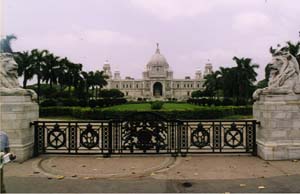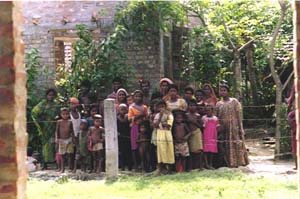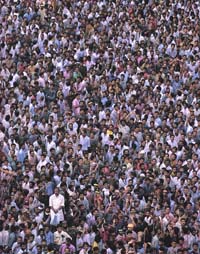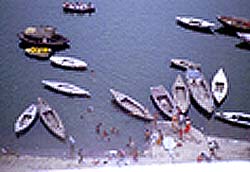Then we visited the city of Mother Teresa's Missionaries of Charity: Calcutta. It was very interesting to us to discover the "other side" of Calcutta, its place as an active center of intellectual enquiry, where native Calcuttans make an extreme effort to overcome the image of a poverty-striken city as portrayed in several books and movies.

The Victoria Memorial is the most solid reminder of British Calcutta. It is a huge white-marble museum that represents a strange combination of classical European architecture with Mughal influences.The foundation stone was laid in 1906 and the building was opened in 1921.
 Outside Calcutta we visited a traditional craft village. The villagers
maintain an active crafts tradition which serves as an additional source
of income.
Outside Calcutta we visited a traditional craft village. The villagers
maintain an active crafts tradition which serves as an additional source
of income.

Above: Silkweaving, one of India's finests traditions

India has the second largest population in the world (900 million) exceeded
only by China. It is still growing far too rapidly, around 2% a year. About
1/3 of the population lives in urban areas but an increased shift from villages
to city has been characteristic over the last 10 years. The literacy rate
is about 55-60% nationally, men are generally more literate than women (about
60% to 40% respectively). Arranged marriages are still the norm rather than
the exception. Girls are often seen as a burden in the family, not only
because they leave the family when married (and consequently are not part
of the parents' "social security" during old age), but also because
an adequate dowry must be supplied.
Varanasi: The city of Siva. Located on the bank of the sacred Ganges River, it is one of India's holiest places. Varanasi is an auspicious place to die because expiring there ensures inmediate passage to heaven and releases the individual from the cycle of rebirth. Ritual bathing in the Ganges washes away all sins (we surely kept each of our sins, since everyone made an effort not to get in touch with the Ganges' waters, which are well known for their high level of pollution and contamination). The city is famous for its public ghats (steps that lead down to the river). Ritual cremation at the edge of the the river is common practice at several ghats.
 When you learn to swim
When you learn to swim
do not enter a river that has no ocean
to flow into, one ignorant of destinations
and only knowing the flowing as its destiny,
like the weary rivers of the blood
that bear the scum of ancient memories,
but go swim in the sea,
go swim in the great blue sea. Kamala Das, 1974
The river is a voice 
in this desert of human lives.
A sail is hoisted,
the color of musk-melon,
the color of daggered flesh.
Beggars hoist their deformities
as boatmen hoist their sails.
The Ganga flows through the land,
not to lighten the misery
but to show it.
Keki N. Daruwalla, 1976